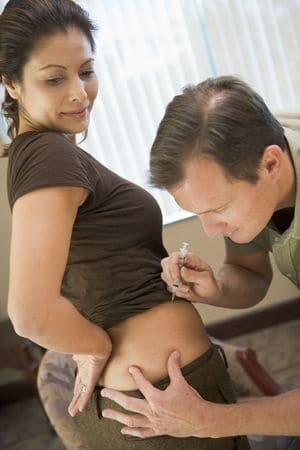One of the most anxiety provoking aspects of infertility treatment is the self-administration of medications. Many people quake at the site of a needle and the prospect of self-injections may seem overwhelming. Prior to beginning any infertility regimen, you are likely to receive instructions from the nursing staff at your fertility clinic. They will give you tips to minimize the pain and discomfort of injections. Despite this, you are now facing the needle(s) in front of you and are terrified. Below are some tips to help minimize the stress and anxiety associated with self-administering shots.
Prior to your first injection, it is important to organize your medications, supplies and instructions. This can help reduce anxiety by minimizing the preparation prior to your shots. It is helpful to complete your injections at the same time each day. Both partners can set an alarm for the chosen time in order to join together for the injection.
One of the most helpful techniques to reduce anxiety is to enlist the support of others. I recommend that couples create an “injection ritual.” By including your partner in the procedures you reduce your own stress and create an opportunity for bonding throughout the process. This is particularly important as it is usually the woman who bears most of the burden of infertility treatment and partners often report feeling marginalized in the process.
To begin creating an injection ritual, set aside a space in your home in which to administer your medications. Some couples find it helpful to decorate this space with candles, incense or even baby-related items. The space should be could be calming and soothing and relatively free from distractions.
Collaborate with your partner about elements to include in your injection ritual. Many couples find it meaningful to incorporate elements from their religious or spiritual traditions. To begin the ritual, take some time to connect with your partner. Check in with each other about your day and any thoughts or feelings that are coming up about infertility. Practice active listening, giving space for each partner to express individual thoughts and feelings. This provides an opportunity for couples to support one another and strengthen their bond.
Following the check-in, practice a brief relaxation, visualization or meditation exercise. Research has demonstrated the effectiveness of all of these methods in reducing anxiety, but experiment and find what works for you. The three-minute breathing space is relatively brief and effective. Please see the link below that provides access to several free guided meditations. Complete this portion of the ritual by setting an intention for your baby and family.
Now that you are hopefully feeling relaxed and connected to your partner, it is time to administer the medications. Decide who will be administering the shots. Some prefer to self-administer the shots while other prefer their partners to do it. There is no right answer and it may take some time to find the best methods for you. A practical suggestion for minimizing discomfort is using ice to numb the area prior to the injection. Warming the medication prior to injections is sometimes helpful. When injecting into a large muscle, massage following the injection is often relieving. Please consult your medical team prior to trying any injection variations.
The most important aspect of working together to create an injection ritual is to communicate with one another about what works and what doesn’t. By creating an injection ritual you are carving out space to discover together how to support one another through this journey towards parenthood.
Click the following link to access free mindfulness exercises.








